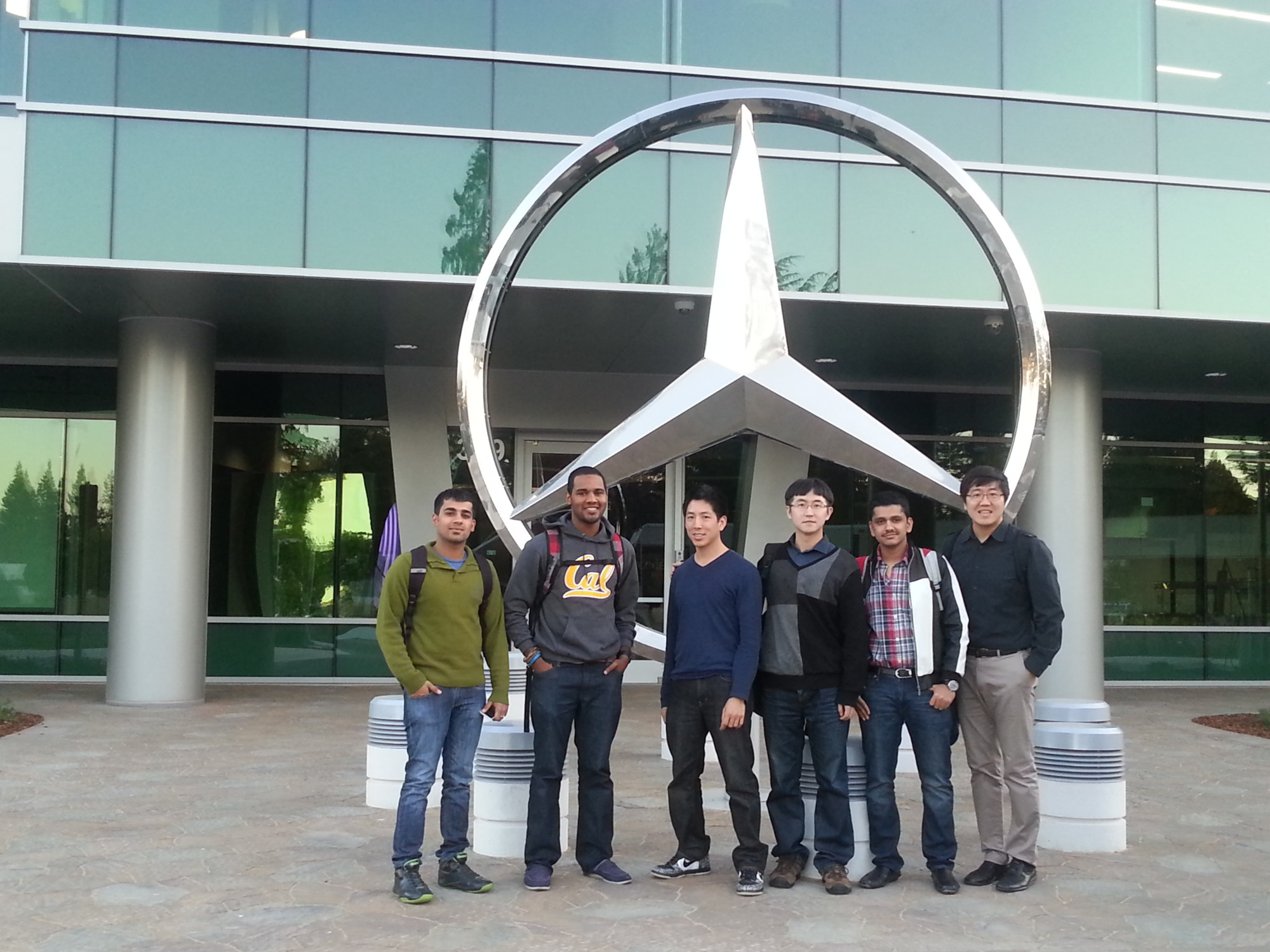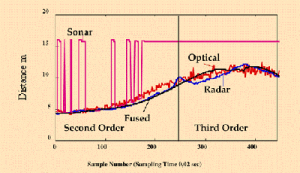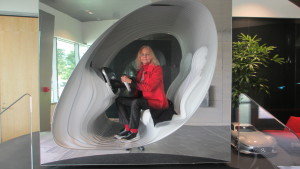 |
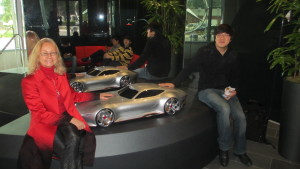 |
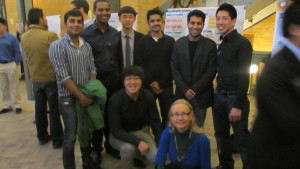 |
Opportunity-Driven Mobility
See our new project: BRAVO (Berkeley Research for Autonomous Vehicle Opportunities)
The Berkeley Research for Autonomous Vehicle Opportunities (BRAVO) group was established to explore and build opportunities spaces for emerging Human-Machine Interactions (HMI) in the era of the autonomous transportation, IoT, and VR/AR. We bring together research, industry, and students to collaborate in the development of new HMI form factors, experience design, or product/service/system concepts, in order to move to the next big paradigm beyond the current implementation of the interaction between autonomous vehicles and users. The main challenge is to: Identify meaningful HMIs and user experiences/scenarios for future fully Autonomous Vehicles.
Mercedes-Benz Experience Design: Future of Mobility Concepts in Suburban America
How to stay one step ahead of the competition with new concepts associated with Being Connected: Mobility Concepts and Services (e.g., Carsharing, Ridesharing, On Demand taxi’s, etc)? Offer customers a holistic approach to mobility – regardless of whether they want to use a car, a bus, a train or some combination.
The objectives of this research are:
- Perform human-centered design research as to user pain points associated with mobility and staying connected.
- Evaluate current concepts and look for gaps and opportunity spaces.
- Prototype and test promising concepts.
In his role as Senior Manager for Business Innovation in the Research & Development division of Mercedes-Benz North America, Rasheq Zarif seeks to change consumer expectations of the automobile. “I should be able to multi-task safely during my commute. I want a car that will keep up with the times. I want to stay connected while driving.”
 Fung MEng Student Team with Sponsor, Rasheq Zarif, Senior Manager for Business Innovation in the Research & Development division of Mercedes-Benz North America
Fung MEng Student Team with Sponsor, Rasheq Zarif, Senior Manager for Business Innovation in the Research & Development division of Mercedes-Benz North America
Rasheq Zarif, Senior Manager for Business Innovation in the Research & Development division of Mercedes-Benz North America, Rasheq Zarif seeks to change consumer expectations of the automobile. “I should be able to multi-task safely during my commute. I want a car that will keep up with the times. I want to stay connected while driving.”
Presentations and Publications
- “Research on Distributed Intelligence: Sensor Fusion and Design Information Environments,” NSF Director Neal Lanes visit to the UC Berkeley campus, Dec. 5, 1996.
- “Experience Design: Mobility and Staying Connected in a Mercedes-Benz”, Midterm Poster Session, Fung Institute for Engineering Leadership, Dec. 2013.
Press
- Implementation at Ladera Ranch: Working with former BEST Labber Rasheq Zarif of Mercedes-Benz, Prof. Agogino’s 2013-14 Masters of Engineering Capstone team developed prototype routings and user interfaces for the project, also with estimates of life cycle energy and carbon benefits. Exclusively for Ranch residents, RanchRide is the convenient, easy and eco-friendly way to get where you want to go.
Autonomous Vehicles
We developed a framework for real time monitoring and diagnosis of automated vehicles in IVHS. This supervisory control methodology is concerned with fault detection, fault isolation, and control reconfiguration of the many sensors, actuators and controllers that are used in the control process. The supervisory control architecture operates at two levels of the AVCS: at the regulation and at the coordination level. Supervisory control activities at the regulation layer deal with validation and fusion of the sensory data, and fault diagnosis of the actuators, sensors, and the vehicle itself. Supervisory control activities at the coordination layer deal with detecting potential hazards, recommending the feasibility of potential maneuvers and making recommendations to avert accidents in emergency situations. The supervisory control activities are achieved through five modules, organized in an hierarchical manner.
Due to the inherent noise of the sensor measurements, the latter are uncertain. Even if several sensors are used, it is not straight forward which sensor to trust or to what degree to trust it. If untreated, the quality of the ride suffers (as demonstrated in this animation) and in the worst case leads to unsafe conditions. Two different approaches for validation and fusion have been investigated: 1.) a probabilistic approach, and 2.) a fuzzy approach. The probabilistic approach is Kalman Filter based and assumes Gaussian noise distributions while the fuzzy approach makes no such assumptions. For fusion, the fuzzy approach uses validation gates which allow the assignment of confidence values to each sensor reading, depending on the sensor characteristics particular to each sensor. Diagnosis of the sensors is performed on-line via fuzzy abductive methods. A ranking scheme calculates fuzzy closeness measures which are used to obtain the most likely failure (if any. Below you can see validated and fused values for longitudinal distance as well as the original sensor values obtained from radar, sonar, and optical sensors.
See this website for more information.
Real-Time Expert Systems: Monitoring, Diagnostics and Supervisory Control (Prior work that forms the foundation for Smart Vehicles research)
- “Sensor-Integrated Expert System for Manufacturing and Process Diagnostics,” (with A. Rege), Knowledge-Based Expert Systems for Manufacturing, ed. by S. C.-Y. Lu and R. Komanduri, ASME PED- vol. 24, 1986, pp. 67-83. Citations.
- “Multiple Sensor Expert System for Diagnostic Reasoning, Monitoring, and Control of Mechanical Systems,” (with S. Srinivas and K. Schneider), Mechanical Systems and Signal Processing, Vol. 2(2), 1988, pp. 165-185. Download pdf of paper. Citations.
- “Real Time Reasoning about Time Constraints and Model Precision in Complex Distributed Mechanical Systems,” (with K. Ramamurthi), Symposium on AI and Limited Rationality (AAAI Spring Symposium Series, Stanford University, March 28-30, 1989), pp. 1-5. Citations.
- “Real Time Expert System for Predictive Diagnostics and Control of Drilling Operation,” (with K. Ramamurthi and D. Shaver), Proceedings of the Sixth IEEE Conference on Artificial Intelligence Applications, (Santa Barbara, CA, March 5-9, 1990.), Vol. I, pp. 63-68 and Vol. II (Visuals), pp. 113-117. Citations
- “Real-Time Expert Systems for Fault Tolerant Supervisory Control”, (with K. Ramamurthi), ASME Transactions, Journal of Systems, Dynamics and Control, Vol. 115, June 1993, pp. 219-227. (Also published in Proceedings of the 1988 ASME International Computers in Engineering Conference, Vol. 2, pp. 333-339.) Citations.
- “Comparing a Neural-Fuzzy Scheme with a Probabilistic Neural Network for Applications to Monitoring and Diagnostics in Manufacturing Systems,” (with K. Goebel, W.R. Wood and P. Jain, ) 1994 AAAI Spring Symposium Working Notes: Detecting and Resolving Errors in Manufacturing Systems, (Stanford University, March 21-23, 1994), pp. 45-50. Citations
- “Fuzzy Belief Nets,” (with K. Goebel), International Journal of Uncertainty, Fuzziness, and Knowledge Systems, Vol. 8, No.4, pp.453-469, 2000. Citations.
- “Sensor Validation and Fusion for Gas Turbine Power Plants Using Fuzzy Techniques,” (with K. Goebel), Mechanical Systems and Signal Processing, pp. 145-146, 2001. Citations.
- “A Methodology for Intelligent Sensor Measurement, Validation, Fusion, and Fault Detection for Equipment Monitoring and Diagnostics,” (with S. Alag and M. Morjaria), AIEDAM (Artificial Intelligence for Engineering Design, Analysis and Manufacturing), Special Issue on AI in Equipment Service, Vol. 15, No. 4, April 2001, pp. 307-319. Citations.
Sensor Validation and Fusion for Autonomous Vehicles
- “ A Framework for Intelligent Sensor Validation, Sensor Fusion and Supervisory Control of Automated Vehicles in IVHS,” (with S. Alag and K. Goebel). Intelligent Transportation: Serving the User through Deployment, Proceedings of the 1995 Annual Meeting of ITS AMERICA, (CASET Associates, LTD, 10201 Lee Highway – Suite 160, Fairfax Virginia 22030), V. 1, pp. 77-87. Citations.
- “Intelligent Sensor Validation and Sensor Fusion for Reliability and Safety Enhancement in Vehicle Control”, (with S. Alag and K. Goebel), MOU132, Final Report, UCB-ITS-PRR-95-40, California PATH Research Report, 1995. (Download ps or pdfversion of report. Citations.
- “A Comprehensive Strategy for Longitudinal Vehicle Control with Fuzzy Supervisory Expert System,” (with Pushkin Kachroo, Masayoshi Tomizuka), 1995 IEEE International Conference on Systems, Man and Cybernetics. Citations.
- “ A Methodology for Intelligent Sensor Validation and Fusion used in Tracking and Avoidance of Objects for Automated Vehicles,” (with S. Alag and K. Goebel). Proceedings of American Control Conference (ACC T95; ISBN 0-7803-2445-5), Seattle, WA, June 1995, pp. 3647-3653. Citations.
- “An Architecture for Fuzzy Sensor Validation and Fusion for Vehicle Following in Automated Highways”, Proceedings of the 29th International Symposium on Automotive Technology and Automation (ISATA), Dedicated Conference on Fuzzy Systems/Soft Computing in the Automotive and Transportation Industry, Florence, Italy, June 3-6, 1996, pp. 203-209. Citations.
- “Inference Using Message Propagation And Topology Transformation In Vector Gaussian Continuous Networks,” (with S. Alag), Proceedings of the 12th Conference on Uncertainty in Artificial Intelligence, 1996, pp. 20-28. See abstract. Citations.
- “Probabilistic and Fuzzy Methods for Sensor Validation and Fusion in Vehicle Guidance: A Comparison,(with K. Goebel and S. Alag), Proceedings of ISATA ’97, 30th International Symposium on Automotive Technology & Automation, (dedicated conference on fuzzy systems/soft computing in the automotive and transportation industry; Florence, Italy 16th-19th ’97), Vol. 1: Mechatronics/Automotive Electronics, pp. 711-719. Citations.
- “Intelligent Sensor Validation and Fusion for Vehicle Guidance Using Probabilistic and Fuzzy Methods,” (with Kai Goebel and Satnam Alag), Final Report for PATH MOU 157, PATH Report #D97-29, 1997.
- “Optimal Safety Decision Making in Advanced Vehicle Control Systems,”(with S. Chao), Proceedings of the 36th IEEE Conference on Decision and Control (Dec. 10-12, 1998, San Diego, CA), IEEE, New York, NY, Cat. No. 97CH3612, Vol. 5, 1997, p. 4788-9.
- “Hazard Diagnosis in Advanced Vehicle Control Systems,” (with S. Chao), Proceedings of the IASTED International Conference on Applied Modelling and Simulation, (August 12-14, 1998), pp. 229-232. Related presentation slides titled “Sensor Modelling and Fusion, and Applications to Hazard Diagnosis for AVCS” at the PATH Program-Wide Research Meeting Richmond Field Station, UC Berkeley, November 5-7, 1998.
- “Intelligent Diagnosis Based on Validated and Fused Data for Reliability and Safety Enhancement of Automated Vehicles in an IVHS,” (with Susan Chao, Kai Goebel, Satnam Alag, Bradley Cammon and Jiangxin Wang,) Final Report for PATH MOU 231, PATH Report #UCB-ITS-PRR-98-17. Citations.
- “Sensor Noise Model Development of a Longitudinal Positioning System for AVCS”, (Jiangxin Wang and Susan Y. Chao),Proceedings of the American Control Conference ’99 (ACC’99; (ACC’99; June 2-4, 1999; San Diego, CA), Session FM11-1, pp. 3760-3764. Citations.
- “Validation and Fusion of Longitudinal Positioning Sensors in AVCS”, (Jiangxin Wang and Susan Y. Chao), Proceedings of the American Control Conference ’99 (ACC’99; June 2-4, 1999; San Diego, CA), Session TM08-2, pp. 2178-2182. Citations.
- “Aggregation of Direct and Indirect Positioning Sensors for Vehicle Guidance,” (with S. Chao, J. Wang and X. Deng), PATH Final Report, MOU 322, UCB-ITS-PRR-2000-24, Dec. 2000.
- “Sensor Validation and Fusion for Automated Vehicle Control Using Fuzzy Techniques,” (with K. Goebel), ASME Trans, Journal of Dynamic Systems, Measurement and Control, Vol. 123, pp. 143-144, March 2001. Citations.
